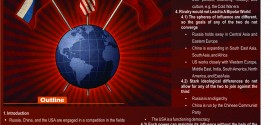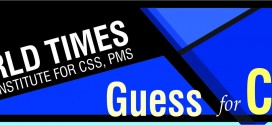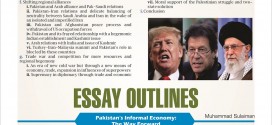1. Introduction
2. Overview of SCO and Its Recent Expansion
a. Establishment of SCO
b. Geographical and historical overview
c. Previous and new members
3. Importance and Significance of SCO in the Contemporary World
a. Enormous potential for trade
b. Shifting the global balance
c. A step toward a multi-polar world
4. Prospects Emerging out of SCO’s Recent Expansion
a. Economic Prospects
i. Increased multilateral trade
ii. Opening up of new transit routes
iii. Increased access to global markets
iv. Cooperation in medicine, energy, food and technology sectors
b. Political Prospects
i. Strong Eurasian bloc
ii. Decreasing tensions among member states
iii. Active role in conflict-resolution
iv. Better cooperation against terrorism
v. Use of ARTS platform for security cooperation
vi. Better border management
c. Social Prospects
i. Effective role against smuggling
ii. Minimizing the drug trade
iii. Cooperation against human trafficking
iv. Cultural exchange
d. Prospects Peculiar to China and Russia
i. Strong regional allies
ii. Access to new markets
iii. Increased influence in global politics
iv. Countering USA’s ‘Pivot to Asia’ policy
e. Prospects Peculiar to Central Asian Republics
i. Infrastructural development
ii. Access to warm waters
iii. Transit route to Africa and Southeast Asia
f. Prospects Peculiar to India and Pakistan
i. Energy trade with Central Asian Republics
ii. Better conflict management
iii. Increased interdependence
5. Challenges Associated with Recent Expansion
a. Political and Administrative Challenges
i. Conflicts among states
ii. Unstable political setups
iii. Lack of political cooperation
iv. Security situation in Afghanistan
v. Terrorism and terrorist organizations
vi. Foreign funding and threat of the ISIS
vii. US influence over India and Pakistan
viii. Pakistan and India’s poor record as SAARC member states
b. Economic and Social Challenges
i. Lack of infrastructure
ii. Underdevelopment prevailing in Pakistan and India
iii. Rough terrain, hard to develop
iv. Lack of funds
v. High dependence on foreign loans
6. Recommendations to Overcome the Challenges
a. Member states should increase political cooperation among them
b. SCO should play active role in conflict-resolution
c. Cooperation on ARTS platform should be enhanced
d. Comprehensive plan should be made against smuggling, drug trafficking, etc.
e. China and Russia should provide loans to other member states
f. Budget of SCO should be increased
g. SCO nations should cooperate in technology
h. Non-tariff trade barriers should be removed
7. Conclusion
Protest Culture in Pakistan and Its Impacts
1. Introduction
2. A Global Overview of Protests
3. Protests and Their Different Forms in Pakistan
a. Sit-ins (Dharnas)
b. Rallies
c. Strikes
d. Blockades
e. Processions
f. Lockdowns (of offices, etc.)
4. Objectives for which Protests are Held in Pakistan
i. Political Objectives
a. Enactment or abrogation of a law
b. Pressurizing the ruling party
c. Show of political power
d. Provision of fundamental rights
e. Holding of early elections by destabilizing the incumbent government
ii. Economic Objectives
a. Increase in salary/wage rates
b. Improvement in facilities at the workplace
c. Provision of basic amenities of life
d. Relief in taxes or other tariffs
e. Favour in economic policy
iii. Social Objectives
a. Support of marginalized segments of society
b. Expediting the criminal justice process
c. Improvements in living conditions
iv. Religious Objectives
a. Supporting some particular religious ideology
b. Supporting some religious personality
5. Impacts of Protests on the Development of Pakistan
A. Negative
i. Political Impacts
a. Tarnished image of the state
b. Diverted attention of the government
c. Violation of human rights
d. Jeopardizing democracy
ii. Economic Impacts
a. Wastage of resources
b. Decline in foreign and local investment
c. Increase in inflation
d. Hurdles in the achievement of national economic goals
iii. Social Impacts
a. Psychological unrest
b. Environment of lawlessness
c. Deleterious impacts on health and education sector
d. Increase in crime
iv. Administrative Impacts
a. Delay in public relief
b. Wastage of time
c. Absence of official discipline
b. Positive Impacts
a. Improved accountability
b. Improved transparency
c. Spread of awareness
d. Provision of rights
6. Why People Resort to Protests?
a. Reactive approach of the government
b. Absence of rule of law
c. Prevalence of pressure groups
d. Involvement of foreign hands
e. Negative role of leaders
f. Incapacity of the law-enforcement agencies (LEAs)
g. Illiteracy and unemployment
h. Provocative role of media
7. Recommendation for Minimizing the Instances of Protests and Mitigating Their Side Effects.
a. Use of proactive approach to avoid the situation
b. Strict implementation of laws
c. Elimination of power groups as soon as they emerge
d. Mature role of politicians
e. Depoliticizing and strengthening the LEAs
f. Focus on education and character-building of the nation
g. Designing and implementation of strict code of conduct for media
h. Vigilant role of security agencies in thwarting foreign involvement
 Jahangir's World Times First Comprehensive Magazine for students/teachers of competitive exams and general readers as well.
Jahangir's World Times First Comprehensive Magazine for students/teachers of competitive exams and general readers as well.



